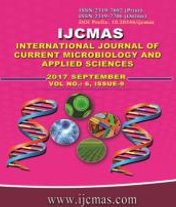


 National Academy of Agricultural Sciences (NAAS)
National Academy of Agricultural Sciences (NAAS)

|
PRINT ISSN : 2319-7692
Online ISSN : 2319-7706 Issues : 12 per year Publisher : Excellent Publishers Email : editorijcmas@gmail.com / submit@ijcmas.com Editor-in-chief: Dr.M.Prakash Index Copernicus ICV 2018: 95.39 NAAS RATING 2020: 5.38 |
Dietary diversity (DD) has been identified as a potentially useful indicator of micronutrient status. Adolescents eating less number of food groups may be at the risk of nutritional deficiency. This study was aimed to determine the dietary diversity in the diets of adolescents and to find its correlation with the probability of adequacy of five micronutrients. Two hundred adolescents (13-17y) were selected randomly from the rural Govt. Senior Secondary School of Dhanger and urban Govt. Senior Secondary School Fatehabad, Haryana. To reflect the dietary diversity, two variables were calculated for each individual: Dietary Diversity Scores (DDS) and Food Variety Scores (FVS). Total food items consumed on two non-consecutive days were categorized into 13 food groups. The DDS was then calculated as the sum of all food groups consumed by an individual. The total score could range from 0 to 13. Probabilities of adequacy (PA) of five micronutrients i.e. for vitamin A, vitamin C, calcium, iron and zinc was calculated based on the Estimated Average Requirement (EAR). Scores for DDS and FVS did not range to the highest possible score. Mean value of DDS was 6.46 (± 1.05). The theoretical range was 1 to 13, while in the sample it varied from 4 to 8. The mean probability of adequacy across five micronutrients among rural adolescents was 57 per cent which was 49 per cent in the urban adolescents. The diets of boys and urban adolescents were more diversified though the limit was not reached to the possible maximum ranges. Adolescents should be educated and motivated to eat all group fruits and vegetables.
 |
 |
 |
 |
 |